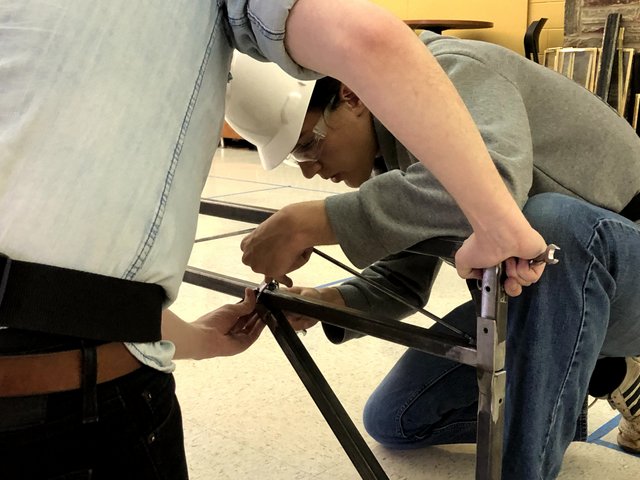More and more, faculty at Temple University are making a discovery of a different sort — the Temple University Ambler campus is an invaluable resource to conduct research and engage in hands-on learning in a broad array of disciplines.
At Temple Ambler, Civil Engineering and Earth and Environmental Science professors are researching seismic waves and earthquakes — an impossibility at Temple’s urban locations — while College of Science and Technology researchers study hydrology, weather and more. Criminal Justice experts are training the next generation of police officers and park rangers on campus while psychology students seek to understand the cognitive development of children in the Temple Infant and Child Lab. Students, faculty and staff also continue to expand a fully accredited aquaponics garden and research lab on campus while Temple Ambler is formally established as a field station.
“There is a great deal more research going on at Temple Ambler than I think most people realize,” said Susan Spinella Sacks, Manager of Research and Grants at Temple Ambler. “At 187-acres of woodlands, meadows, formal gardens, streams and more, one of the greatest resources that Temple Ambler provides to the University is space and a rich tapestry of environments in which to conduct research. Seismology, hydrology, stormwater management, horticulture, planning, landscape architecture, transportation, art, biology — there are so many hands-on learning opportunities to offer on campus.”
Temple Ambler, Sacks said, has resources available that are unique to the University “that allow students to really dig into what they are learning.”
 “We have engineering students in their Senior Design capstone course building a green wall that will be implemented on Bright Hall. In this instance, they can’t attach it directly to the wall, so they need to find creative solutions to achieve success,” she said. “They are not just working with models or determining hypotheticals. Our students are engaging in real-world applications for what they are learning.”
“We have engineering students in their Senior Design capstone course building a green wall that will be implemented on Bright Hall. In this instance, they can’t attach it directly to the wall, so they need to find creative solutions to achieve success,” she said. “They are not just working with models or determining hypotheticals. Our students are engaging in real-world applications for what they are learning.”
With the support of Dr. Robert Ryan, Associate Professor of Instruction in Civil and Environmental Engineering in the College of Engineering, Civil Engineering students have been involved in not one but three hands-on projects throughout the spring semester at Temple Ambler, which resulted in the creation of a concrete canoe, a 23-foot-long steel bridge and ongoing work on the green wall.
“One of the fundamental opportunities at Temple Ambler is the availability of space. Engineering is squeezed to the bone for space. In terms of research and teaching opportunities, we need space to create hands-on experiences for our students to learn their craft,” said Ryan, who himself has been involved in a diverse array of research originating at Temple Ambler with a multidisciplinary team of faculty. “For example, there is a competition that Engineering takes part in to build a concrete canoe — the project was advised by Dr. Bechara Abboud. It’s very difficult to find a location to build a 23-foot-long canoe but Temple Ambler opens up a world of opportunities – you can experiment and get right to work.”
Being able to work at the Ambler Campus, Ryan said, “has provided our students an opportunity to work on projects that might not have been available to them and to look at these projects from different angles as they confer and work closely with students and faculty from other disciplines.”
For much of the spring semester, the Campus Lounge in Bright Hall at Temple Ambler was often transformed into a base of operations for a team of Civil Engineering students that have spent three semesters “experiencing the civil design process from start to finish,” said Civil Engineering senior Kenneth Kiocho. The project was overseen by Dr. Sanghun Kim
“The task of our 16-member team was to design and build a 23-foot-long bridge for the American Institute of Steel Construction's Steel Bridge Competition,” he said. “Our team has been using the lounge in Temple Ambler's Bright Hall to practice building the bridge — we only have 45 minutes during competition — which must be able to hold 2,500 pounds.”
While time was not their friend at the Mid-Atlantic Regional competition held at the University of Pittsburgh at Johnstown, “the entire project has given us tremendous insight into the whole design process,” said Kiocho.
“It makes you realize what you’ll be facing with full size engineering projects and how essential teamwork will be in that process,” he said. “Temple Ambler has been a huge help in providing us the space in which to work and store our materials. We never had to worry about having somewhere to work and plan out the project.”
From an educational and research perspective, “Temple Ambler is a very collegial place,” said Ryan.
“It’s very open. The people I’m working with want to know what I’m thinking and I want to know what they are thinking. It’s a place where you want to share your work, a place where people help each other,” he said. “That collaborative environment helps generate ideas, which sparks innovation. It frees your mind, which I think is one of the best things about Temple Ambler.”

